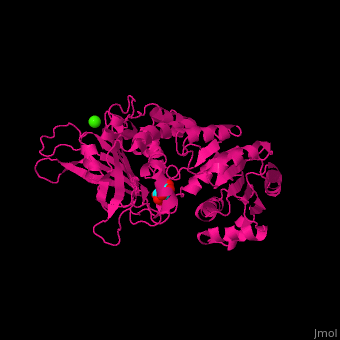Glucose 6-phosphate dehydrogenase
From Proteopedia
(Difference between revisions)
| (15 intermediate revisions not shown.) | |||
| Line 1: | Line 1: | ||
| - | <StructureSection load=' | + | <StructureSection load='' size='350' side='right' caption='Structure of glucose 6-phosphate dehydrogenase complex with glucose 6-phosphate and Ca+2 ion (green) (PDB code [[1e77]]).' scene='72/723863/Cv/1'> |
== Function == | == Function == | ||
| - | '''Glucose 6-phosphate dehydrogenase''' (G6PD) catalyzes the conversion of glucose 6-phosphate to 6-phospho-glucono-1,5-lactone. G6PD uses NAPD as cofactor<ref>PMID:9553122</ref>. See also [[G6PD (Hebrew)]]. | + | '''Glucose 6-phosphate dehydrogenase''' (G6PD) or '''6-phosphogluconolactonase''' catalyzes the conversion of glucose 6-phosphate (G6P)to 6-phospho-glucono-1,5-lactone. G6PD uses NAPD as cofactor<ref>PMID:9553122</ref>. G6PD is found in the cytoplasm and its function is protection against oxidative damage caused by metabolism. G6PD is part of the pentose phosphate cycle which is part of the cellular carbohydrate synthesis.<br /> |
| + | See also [[G6PD (Hebrew)]]. | ||
== Disease == | == Disease == | ||
| - | G6PD deficiency predisposes toward hemolytic anemia<ref>PMID:18177777</ref>. | + | G6PD deficiency is genetically recessive and predisposes toward hemolytic anemia<ref>PMID:18177777</ref>. This disease is not fatal if the carrier maintains a suitable diet and uses appropriate drugs like corticsteroids. G6PD deficiency in red blood cells causes lack of NADPH which results in oxidative damage of the cell membrane and its rupture. |
== Structural highlights == | == Structural highlights == | ||
| - | <scene name='72/723863/Cv/ | + | <scene name='72/723863/Cv/8'>G6PD active site contains predominantly charged residues</scene> |
| - | <scene name='72/723863/Cv/ | + | <scene name='72/723863/Cv/9'>Ca coordination site</scene> (PDB code [[1e77]]), water molecules shown as red spheres. <ref>PMID:11106478</ref> |
</StructureSection> | </StructureSection> | ||
| Line 24: | Line 25: | ||
*Glucose 6-phosphate dehydrogenase | *Glucose 6-phosphate dehydrogenase | ||
| + | **[[7zve]] – hG6PD - human<br /> | ||
**[[1dpg]], [[1e7m]], [[1h93]], [[1h9b]] – LmG6PD (mutant) – ''Leuconostoc mesenteroides''<br /> | **[[1dpg]], [[1e7m]], [[1h93]], [[1h9b]] – LmG6PD (mutant) – ''Leuconostoc mesenteroides''<br /> | ||
**[[3e15]] – G6PD – ''Plasmodium vivax''<br /> | **[[3e15]] – G6PD – ''Plasmodium vivax''<br /> | ||
**[[3c8n]] – MtG6PD (mutant) – ''Mycobacterium tuberculosis''<br /> | **[[3c8n]] – MtG6PD (mutant) – ''Mycobacterium tuberculosis''<br /> | ||
| - | **[[ | + | **[[6d23]] – TcG6PD – ''Trypanosoma cruzi''<br /> |
| - | **[[ | + | **[[4lgv]] – G6PD – ''Mycobacterium avium''<br /> |
| + | **[[5lxe]] – G6PD – ''Rhodococcus jostii''<br /> | ||
| + | **[[7e6h]] – KlG6PD – ''Kluyveromyces lactis''<br /> | ||
| + | **[[7zht]] – LdG6PD – ''Leishmania donovani''<br /> | ||
| + | **[[7xhp]] – ZmG6PD – ''Zymomonas mobilis''<br /> | ||
| + | **[[9emn]] – SyG6PD - ''Synechocystis'' – Cryo EM <br /> | ||
| - | *Glucose 6-phosphate dehydrogenase | + | *Glucose 6-phosphate dehydrogenase complex |
| + | **[[1qki]], [[2bh9]], [[6e08]], [[6e0j]], [[6jyu]], [[7zvd]] – hG6PD + NADP - human<br /> | ||
| + | **[[6e07]], [[6va0]], [[6va7]], [[6va8]], [[6va9]], [[6vaq]] – hG6PD (mutant) + NADP <br /> | ||
| + | **[[2bhl]], [[5ukw]] – hG6PD (mutant) + G6P<br /> | ||
| + | **[[6d24]] – TcG6PD + G6P<br /> | ||
| + | **[[5aq1]] – TcG6PD + G6P + NADP<br /> | ||
| + | **[[3b4y]] – MtG6PD (mutant) + coenzyme F420 <br /> | ||
**[[2dpg]], [[1h9a]] – LmG6PD (mutant) + NADP<br /> | **[[2dpg]], [[1h9a]] – LmG6PD (mutant) + NADP<br /> | ||
**[[1h94]] – LmG6PD (mutant) + NAD<br /> | **[[1h94]] – LmG6PD (mutant) + NAD<br /> | ||
| - | **[[1e77]] – LmG6PD (mutant) + | + | **[[1e77]] – LmG6PD (mutant) + G6P<br /> |
| - | **[[1e7y]] – LmG6PD (mutant) + | + | **[[1e7y]] – LmG6PD (mutant) + G6P + NADP<br /> |
| - | **[[ | + | **[[7e6i]] – KlG6PD + G6P <br /> |
| - | **[[ | + | **[[7xhl]] – ZmG6PD + NADP derivative<br /> |
| - | **[[ | + | **[[7zhu]] – LdG6PD + NADP <br /> |
| - | **[[ | + | **[[7zhx]], [[7zhy]] – LdG6PD (mutant) + NADP <br /> |
| + | **[[7zhv]] – LdG6PD + G6P <br /> | ||
| + | **[[7zhw]] – LdG6PD + G6P + NADP <br /> | ||
| + | **[[7zhz]] – LdG6PD (mutant) + G6P + NADP <br /> | ||
| + | **[[9emm]] – SyG6PD + OpcA – Cryo EM <br /> | ||
}} | }} | ||
== References == | == References == | ||
<references/> | <references/> | ||
| + | [[Category:Topic Page]] | ||
Current revision
| |||||||||||
3D structures of glucose 6-phosphate dehydrogenase
Updated on 10-July-2025
References
- ↑ Tian WN, Braunstein LD, Pang J, Stuhlmeier KM, Xi QC, Tian X, Stanton RC. Importance of glucose-6-phosphate dehydrogenase activity for cell growth. J Biol Chem. 1998 Apr 24;273(17):10609-17. PMID:9553122
- ↑ Cappellini MD, Fiorelli G. Glucose-6-phosphate dehydrogenase deficiency. Lancet. 2008 Jan 5;371(9606):64-74. doi: 10.1016/S0140-6736(08)60073-2. PMID:18177777 doi:http://dx.doi.org/10.1016/S0140-6736(08)60073-2
- ↑ Cosgrove MS, Gover S, Naylor CE, Vandeputte-Rutten L, Adams MJ, Levy HR. An examination of the role of asp-177 in the His-Asp catalytic dyad of Leuconostoc mesenteroides glucose 6-phosphate dehydrogenase: X-ray structure and pH dependence of kinetic parameters of the D177N mutant enzyme. Biochemistry. 2000 Dec 12;39(49):15002-11. PMID:11106478
Proteopedia Page Contributors and Editors (what is this?)
Michal Harel, Joel L. Sussman, Alexander Berchansky, Jaime Prilusky

